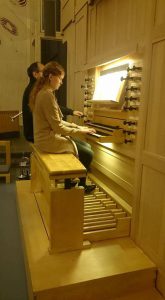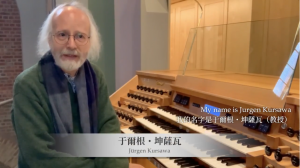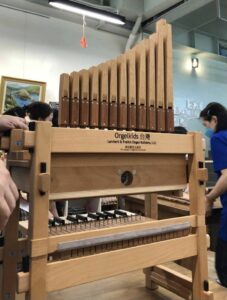離開木工區之後,我們走進了音管製作區,是在建築物的後側。在我們走進去之前,就有一位音管製作學徒遞上安全護目鏡和消音耳機給我們。一走進音管製作區,我們立刻明白他的用意了:在角落擺著一張龐大的工作檯,會有薄薄一層高溫金屬溶液被平鋪在上面,冷卻後便成為一張金屬薄片。金屬薄片冷卻後再用一支大型的自動榔頭搥打很長的時間,讓它的厚度統一,也就是讓整片金屬的每個地方一樣厚。以前的工人必須用人力搥打這片金屬,非常費力!這個搥打的過程由於幾種原因相當重要,但其中最實際的原因之一就是重力問題:如果音管有一側金屬片比較厚,重力會導致它承受的拉力不平均,造成音管向一側崩塌。而且這不只是重力問題,還有一部分是所使用的金屬種類的問題。音管常用的金屬是一種含鉛量很高的合金,這種金屬本身非常軟,讓音管製作者容易將之彎曲塑形,但也代表日後音管很容易崩塌。確實如此,音管有時候實在太重了,於是開始向下沉,這時候音管開口處附近的金屬便開始隆起,有點像是胖嘟嘟的嬰兒臉頰,管風琴建造家就會說音管在「微笑」了!經過長時間的搥打之後,金屬片會被切割成正確的大小和形狀,符合每個要使用金屬片的音管尺寸。
「好,可是,」另一個學生開口了:「既然鉛很軟又很重,為什麼要用鉛?怎麼不用比較輕、比較硬的金屬呢?」
這位導覽員回答:「這個問題非常好!其實從古至今曾經使用過別種金屬和合金,從法國和英國在幾個世紀前使用的錫管,到現代的大型音管所用的鋅。錫管可以擦得閃亮耀眼,所以法國的古典管風琴正面會有錫製的音管。英國人使用錫則是因為英國的錫礦藏量豐富,用來製造音管的成本比在歐陸國家便宜。還有很多歐洲的管風琴建造家倚重鉛合金,或許是因為用鉛比向英國買錫便宜。比較晚近的現代建造家則開始用鋅或其他金屬製作最大型的音管,因為鋅比鉛更堅硬且質地較輕。但是有一個難題:鋅不像鉛那麼柔軟,要搥打和塑形就比較費力,尤其是管風琴完成幾年後需要修補凹痕的時候。」
看完了高溫金屬溶液倒在鑄造檯上塑型,以及學徒將之搥打成薄片並加以切割之後,我們接著觀看音管製作師傅把冷卻的金屬片捲成圓形音管。這個部分需要把金屬片包覆在一個稱為心軸的實心金屬圓筒上,做出適當的形狀,然後把兩端焊接起來。焊接需要用手操作一種特別的工具,以少量高溫的金屬溶液將兩端密封住,有點像是用膠水把兩張紙連接起來,只是需要做得更仔細,而且要做出圓管並不只是把金屬片的兩端連接起來而已。別忘了,音管的底部是圓椎形,需要有自己的接縫,而每個音管裡還有一個舌頭狀的薄片,稱為簧舌,這些零件都必須用高熱的金屬溶液完美地黏合。
即使這些工作都完成了,音管也還不能用來演奏,還需要從管身切割一個開口,然後在一個特別的機器上試音。這台試音機就是一個小型風室,有一組短短的鍵盤,試音員會把每個音管都放在機器上,然後按一個琴鍵,就像彈奏管風琴一樣。然後他會調整音管的形狀來改變它發出的聲音,讓它更宏亮或更柔和、調整風道入口慢一點或快一點。可見,製作音管和試音的學徒得習藝多年,才能學會處理這些工具和材料的技術,製作出精巧的音管,可以發出美妙的樂音。他們不但要鑄造出精美的零件,也要聽清楚音管發出的樂音。
這還只是唇管,我們得等到下一次再參觀簧管的製作。此時我們離開音管和木工區,走過中央分隔牆的小門,進入這棟屋子的另一邊。一走進來,立刻感覺空氣變涼了,也注意到房間後側一角的天花板特別挑高。現在終於了解我們從外面看到的奇怪塔樓了:這是安裝區,完工的管風琴可以在這裡完全組裝起來,不管有多高。原來新的管風琴會先在工作室裡組裝、然後再拆解,之後才在最後的新家重新組裝起來,真是令人驚奇!這些工作都需要很多人力,也得費力搬動這些沉重的零件。
「為什麼要安裝兩次呢?怎麼不等到運到演奏地點之後再安裝呢?」有一個學生很好奇地發問。
「這也是個很有意思而且很重要的問題!」她回答。「第一,管風琴建造者必須確保每個零件都和其它的零件完美搭配,這就需要讓管風琴在出廠之前可以完整彈奏。由於管風琴非常複雜,這就成為最後而且非常重要的步驟,讓我們有機會檢查我們的工作,找出任何問題或錯誤。」
管風琴在安裝區經過測試之後,終於可以運送到新家了。工作人員會將它拆解,非常仔細地把每個零件標註好、包裝好。音管必須用許多柔軟的包裝材料包好、放進堅固的木箱裡,以免製造出凹痕。然後,所有包裝好的零件都會排在工作室大門旁的臨時台架區,然後會有大型貨櫃卡車駛近大門口——有時甚至得用一個列車來載運——這樣就可把每個零件直接裝上卡車。管風琴會從這裡直接被載到新家,也有一些情形比較特別,會裝載上船再運往海外的國家。
你的朋友蔣士挺
Where do organs come from? (part 2)
As we leave the wood working shop, we walk into the pipe making shop, which is in its own room at the back of the building. But before we can enter, a pipe making apprentice gives us pairs of safety goggles and noise cancelling headphones to wear. As soon as we enter the pipe shop, we understand why: in one corner is the enormous table, the ‘bed’ where hot liquid metal is poured out flat to cool into a thin sheet. After it is cooled, it must be pounded for a long time by a large automatic hammer to make it uniformly thin; in other words, it must be the same thickness everywhere. Historically, workers had to hammer the metal by hand — what a job! This process of pounding is important for several reasons, but perhaps one of the most practical is a problem of gravity: if the metal is thicker on one side of a pipe, then gravity will begin to pull unevenly on it, causing the pipe to begin collapsing to one side. This is not only a problem of gravity, however. It is partly due to the type of metal used. ‘Common pipe metal’ is an alloy high in lead, which is itself a very soft metal. That same softness makes it easy for the pipe makers to bend and shape the metal, but it also means that the pipes can easily collapse later. Indeed, sometimes pipes are just so heavy all around that they begin to sink straight down. When this happens, the metal around the mouth begins to bulge, a little bit like chubby baby cheeks, and so builders say the pipe is ‘smiling’! After being hammered for a long time, the metal is cut to the correct size and shape for each pipe using metal sheers.
“Okay, but wait:” chimes in another student. “Why use lead if it’s so soft and heavy? Why not a lighter, stronger metal?”
Our apprentice guide responds, “That’s a very good question. In fact, other types of metals and alloys have been used throughout history, from tin pipes in France and England a few centuries ago, to zinc for large pipes in modern instruments. Actually, tin shines brightly when polished and looks striking. This is why, for example, French Classical organs had tin pipes for facades. The British may have used tin because England had large reserves of the metal, which made it cheaper for English builders to use than for their continental counterparts. Many other European builders relied on lead alloys, possibly because it was cheaper for them than buying tin from England. Later, more modern builders began using zing, or even other metals, for the largest pipes because they are both stronger and lighter than lead. But there’s a catch: since zinc is not as soft as lead, it can be harder to hammer and shape zinc, especially when trying to repair dents in pipes years after the organ is built.”
After we watch the fiery display of molten metal being poured onto the casting table, and then see apprentices pounding it into thin sheets and cutting it, we turn to observe the master pipe makers rolling the cooled sheets into round pipes. To do this, the metal is wrapped around another solid metal cylinder, called a mandrel, to create the proper shape. Then, the two edges of the sheet are soldered together where they meet. Soldering requires a special hand tool that can use a little hot liquid metal to seal together two pieces of metal. It’s a little like using glue to connect two pieces of paper, except strangely, it’s more delicate work. But it’s also not as simple as connecting two ends of a sheet of metal to make a round pipe. Remember, the bottom of the pipe is the shape of a cone, which requires its own soldered seams, and inside each pipe is a flat piece like a tongue, called the languid. All of those parts must be connected perfectly using the hot metal solder.
Even after completing all that, the pipe isn’t yet playable. The mouth still has to be cut out of the pipe body, and the pipe then voiced on a special machine. This voicing machine is a miniature windchest with a short keyboard. The pipe voicer places each pipe on the machine and plays it by pressing down a key, just like playing the organ. He can then make adjustments to the shape of the pipe to change its speech — louder or softer, faster or slower. All of this means that pipe making and voicing apprentices must work for years to learn the art of handling all these tools and materials just to produce a single, well-crafted pipe that plays beautiful sounds. Their work is as much about crafting beautiful objects as it is about listening for musical sounds.
And these are just the flue pipes. We will have to wait for another visit to the workshop to learn about making reed pipes. For now, we leave the pipe making and wood working rooms, passing through the door in the center wall leading to the other side of the building. Entering that side, we immediately feel the air grow a little cooler as our eyes are drawn upward toward the much higher ceiling in the back corner of the room. Now we finally understand the secret of the strange tower we saw from outside: this is the erecting room, where finished organs can be completely assembled, no matter how tall they are. What a surprise to learn that new organs are put together in the shop, then disassembled, and then reassembled in their final homes! All that work requires a lot of people and much heavy lifting.
“Why erect an organ twice? Why not just wait until it arrives in its new performance space?” asks a curious student.
“Another interesting and important question!” she answers. “First, it is important for the organ builders to check that every part works perfectly with all the other parts, and this requires making the organ completely playable before it leaves the workshop. Because the organ is so complicated, this is the final, all-important step that gives us the opportunity to check our work and identify any problems or mistakes we’ve made.”
Once the organ has been tested in the erecting room, it is finally ready to be moved to its new home. The workers take it apart, labelling and packing everything with extreme care — the pipes must travel in sturdy wooden crates with lots of soft packing material to prevent them from getting dented — and organize all the packed parts in the staging area next to a large door at the side of the workshop. Only after all this, a large container truck will pull up next to this door — or sometimes even a train! — so everything can be loaded directly into the truck. From there, the organ will either be driven to its new home or, in some extraordinary cases, it will be loaded onto a ship and sent overseas.
Your Friend,
Justin





